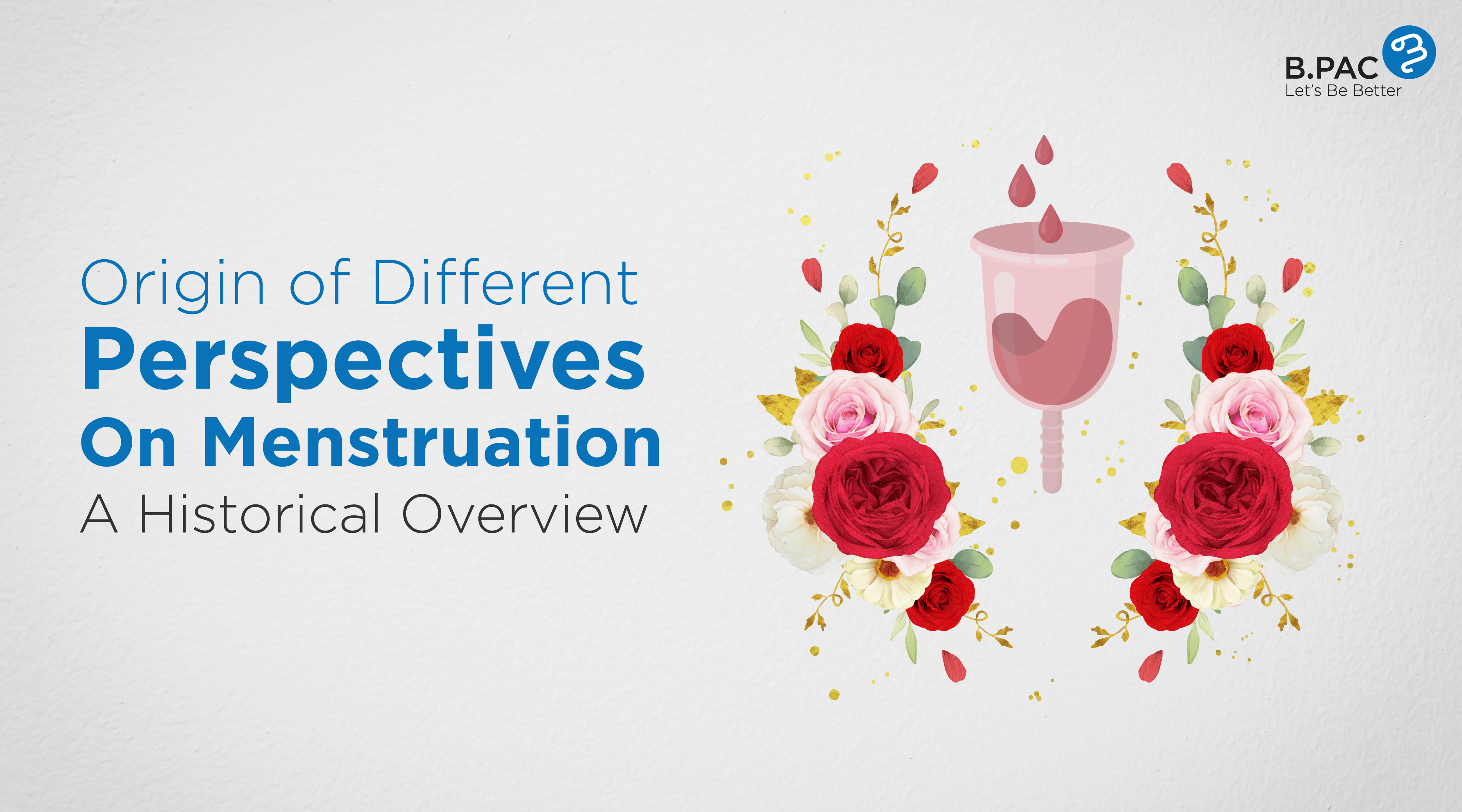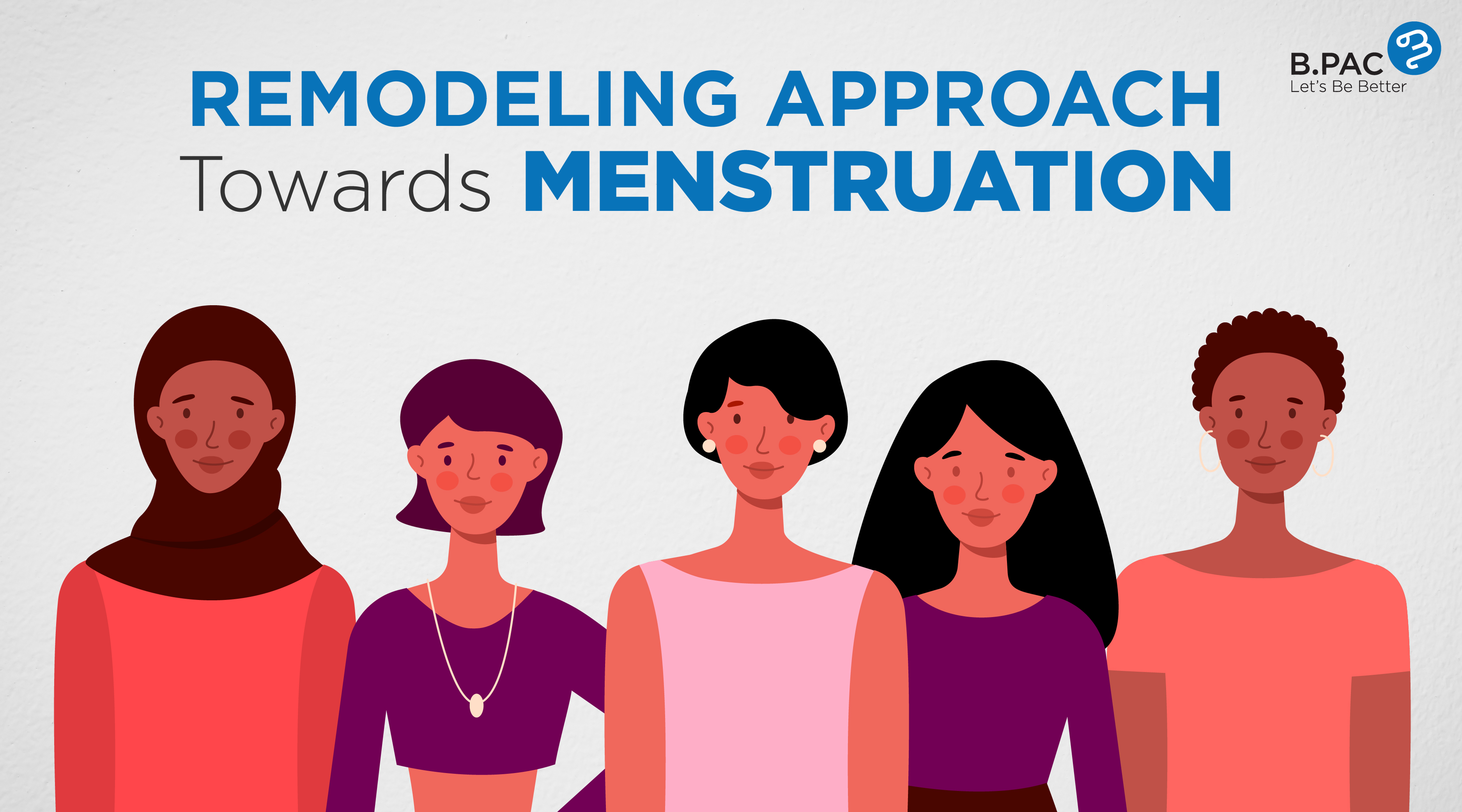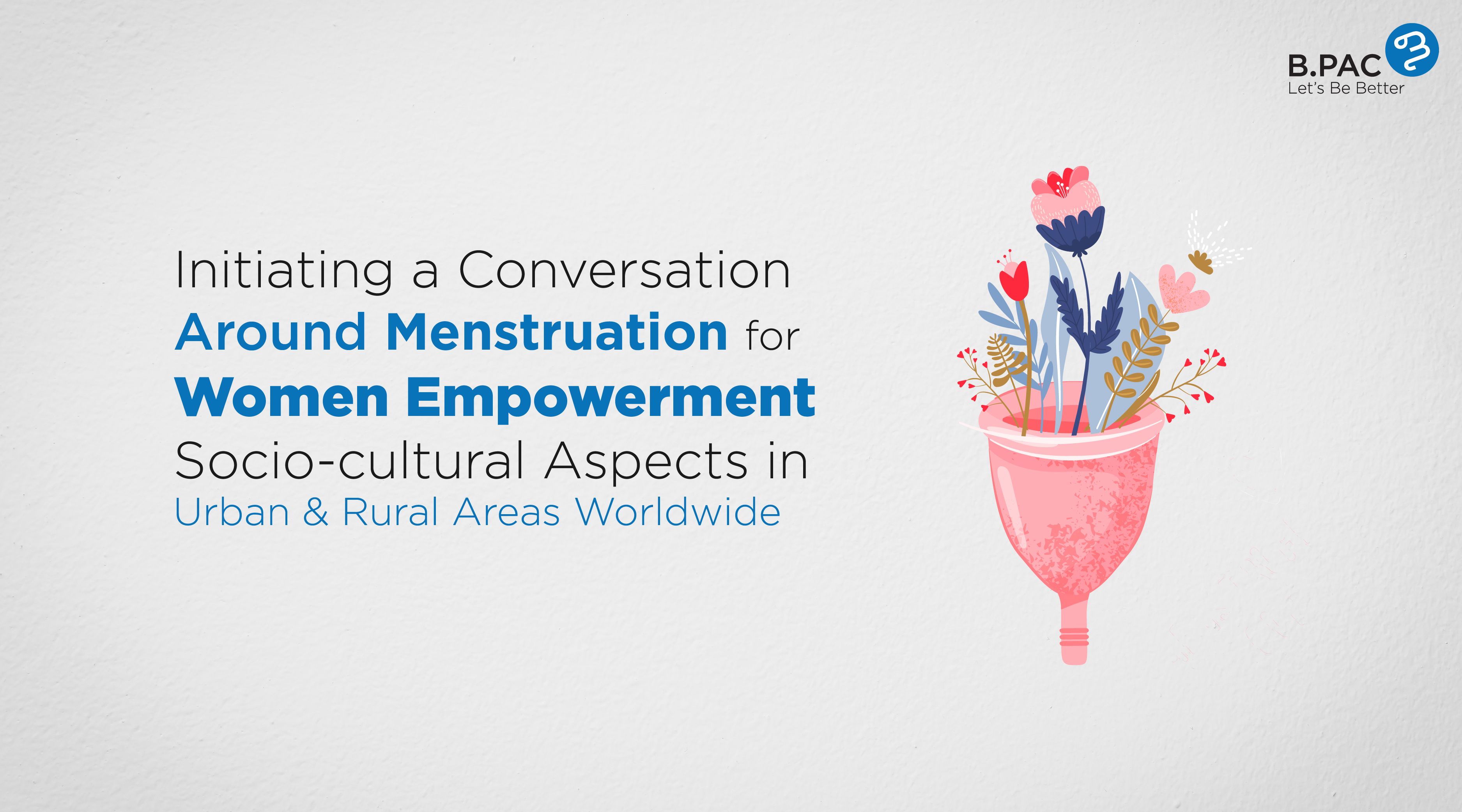Menstruation, a biological phenomenon unique to girls, is subject to the misogyny that manifests in taboos and myths that outcast women from many aspects of their socio-cultural life. ‘Women while menstruating can’t visit holy places’, ‘Girls on periods should not touch food as it leads to contamination’, ‘Menstruation is a disease for women who have sinned’, ‘Menstruating women are capable of witchcraft’. These are a few misconceptions that have existed since ancient times and are prevalent even today. What is the reason behind them?
While menstrual taboos are nearly universal, there are few exceptions. For example, since ancient times, menstruation holds spiritual importance for indigenous Cree tribes of Canada & Native Americans who consider periods a powerful, healing and sacred process. As per an article by author Greg Jenner, women earlier were more likely to have lighter periods due to poor diet & malnourished body and started menopause at 40. Historians also believe that Egyptians & Romans often associated menstruation with magic & sorcery before the 5th century. An ancient Roman philosopher & author, Pliny, the Elder, documented menstruating women as capable of warding off hailstorms, lightning and killing crops. Pliny’s theory also states menstrual blood is so powerful that consuming it would guarantee a person’s fidelity for life, a trick employed by a maid from Hong Kong in 2009! Like these, the history of menstruation is shrouded with myths & misconceptions. One of the primary reasons is that ancient authors & philosophers were always men with little to no factual information about menstruation. Today, the modern world is equipped with correct biological knowledge about menstruation, proving nothing supernatural or dirty about periods. With so much medical advancements, do you think the existence of stigma is justified? There has also been significant development on how women manage menstruation with choices like sanitary napkins, tampons, even menstrual cups. But has it always been the same? Let’s have a quick overview to get precise knowledge about the origin and history of menstruation.
Time Tunnel for a history of menstruation
Ancient Times: (3000 BC – 5th Century AD)
As per Historians, not much information has been documented about menstruation. Ancient Egyptians made tampons out of softened papyrus. At the same time, Hippocrates, Father of Medicine, wrote that Ancient Greek women used to make tampons by wrapping bits of wood with lint. Some women were also thought to use sea sponges as tampons. The Greeks also believed that if a girl’s period was late, the blood would accumulate in heart & her uterus would wander around her body resulting in erratic behavior & suicidal thoughts! This emotional outburst came to be known as ‘hysteria’ which is derived from Greek word ‘uterus’.
Medieval era (5th – 15th Century)
Things didn’t get any better during the Medieval Period, as there was a lot of religious shame surrounding menstruation. Blood was believed to contain the body’s toxins, and so menstrual blood had always been considered dirty, and some even believed that drinking it may cause leprosy. Men also believed a drop of menstrual blood would burn up their reproductive organs & if a woman got her period during pregnancy, her child would be possessed by the devil. Another common belief was that burning a toad and wearing its ashes around your neck would ease cramps. To hide their cycles, women used to carry pouches of sweet-smelling herbs.
Victorian era:
1882
The word “period” came into existence. The word finds its origin in Greek words “peri” & “hodous”, meaning “around” & “way/path”. This eventually turned into Latin “periods”, meaning “recurring cycle”.
The 1850s
During the menstrual time of the month, women would pin cotton and flannel into their bloomers. The sanitary apron was later invented, primarily a rubber apron with a strip that would run between the legs to prevent blood from leaking into skirts and seats. Hoosier Sanitary belts were introduced; odd contraception worn with cloth belts onto which absorbent fabric could be pinned like a pad. These came into use in the late 19th Century.
1896
The first commercially available disposable menstrual pads that hit the market were named Lister’s Towels, developed by Johnson & Johnson. However, menstruation was still a huge taboo, so not many women were encouraged or were seen purchasing Lister’s Towels, and the product was a failure. Many nurses in hospitals started using wood pulp bandages as pads due to their highly absorbent nature. Other brands like Hartman’s Hygiene Towelettes were later manufactured & launched during the early 1990s.
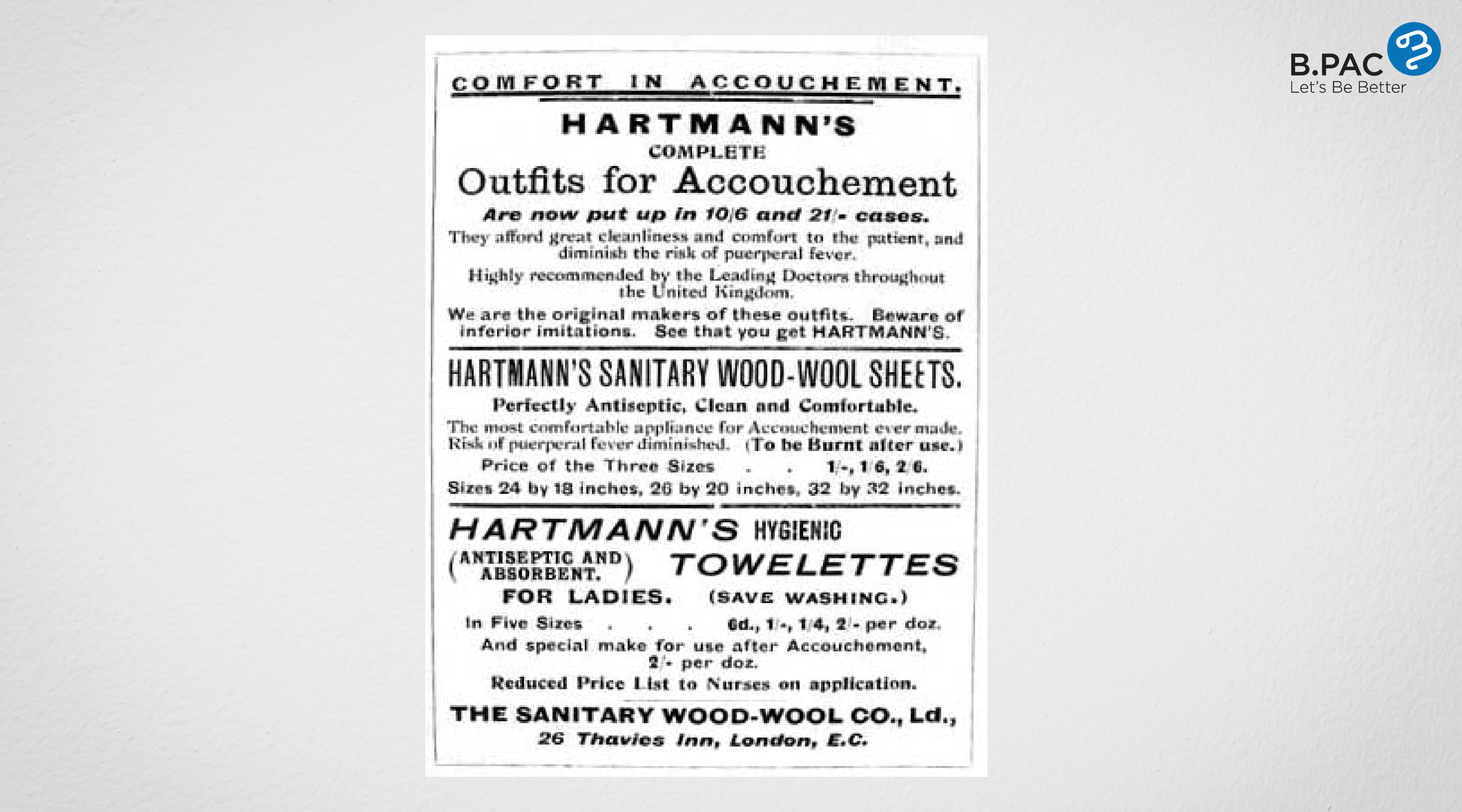
Modern Era:
1919
Professor B. Schick introduced the concept of “menotoxins“, a name for the poison in women’s menstrual flow that could cause the wine to spoil and flowers to wilt. During this time, men kept publishing Pliny’s outdated theories into the medical community giving rise to more misconceptions.
1920
French WWI nurses started creating the modern pads where they used extra cellulose, a blend of acrylic cotton used for bandages, to soak up their menstrual blood. Kotex then developed a cellulose pad for commercial sale in North America & pad sales finally took off when wealthy white women were seen purchasing boxes of pads and leaving a nickel on the department store counter for total discretion of their identity.
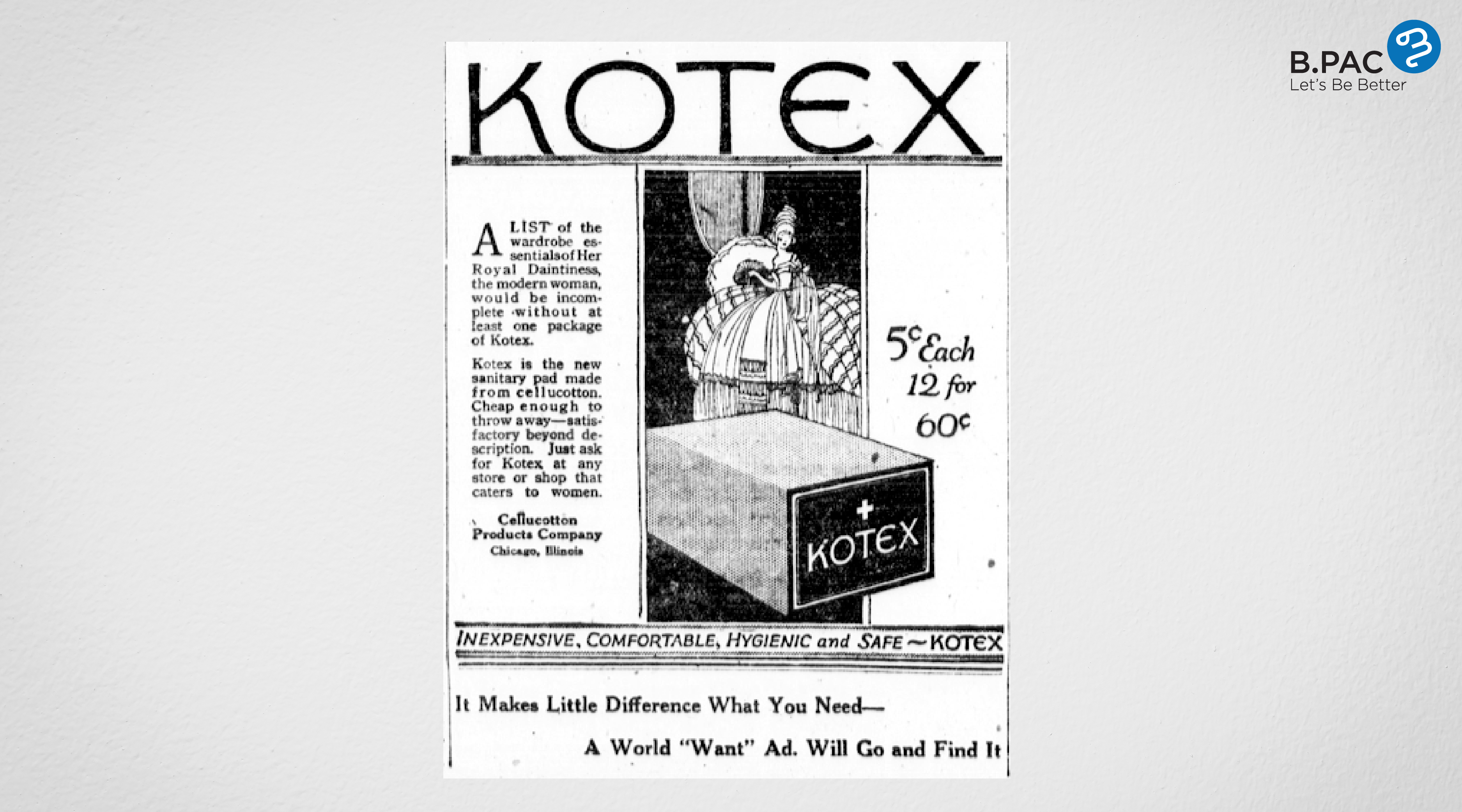
1922
The Hoosier menstrual belt was finally patented and remained a popular method of menstruation management.
The late 1920s
The first commercially available tampons were invented by Dr Earle Haas, who got the idea from a friend who used to tuck in sponge for absorption. The modern tampons came with cotton & applicators, which allowed women to insert & remove without having to touch menstrual fluid. However, tampon applicators were quite leaky and uncomfortable, and Pads overtook tampon sales, boasting a “leak-free” solution.
The 1930s
Leona Chalmers, an American actress, invented the menstrual cup, a rubber cup that stayed in the vaginal canal and collected menstrual fluid. Menstrual cups are still in use today; however, they did not gain any commercial success during the 1930s.
1969
Like the Hoosier belt, the belted sanitary napkins had almost entirely faded out & pads by now had adhesive strips on the bottom that could be attached to the underwear. In the next few decades, pads were made more absorbent to avoid leaking. Stayfree marketed the first-ever pad with an adhesive strip, putting an end to menstrual belts.
1975
Rely brand brought tampons to the market, which were ultra-absorbent, made of polyester and carboxymethyl cellulose. Unfortunately, these materials also breed bacteria faster than cotton, and Toxic Shock Syndrome awareness started spreading, so the Rely tampons were recalled in 1980.
1981
Two women were acquitted by British courts, charged with murder. The reason behind the crime was PMS-led temporary insanity which remained a legal defence to crime charges.
1985
The word “period” was spoken aloud in a commercial for the first time by Courtney Cox in an ad for Tampax.
The 2000s- Present
Menstrual cups have made a comeback as an environmentally safe alternative to pads and tampons. The trend towards more transparency and broader consumer awareness has allowed direct-to-consumer companies like Cora, Lola and Sustained Natural to launch 100% organic cotton tampons. Today women care about what they would use for their bodies and are receptive to alternative options. Talking about the present trend, women now are more hygiene conscious and prefer sanitary napkins freely.
Despite the development, women in remote areas still use rags, ashes & leaves on periods due to period poverty & lack of awareness. The taboo in society surrounding menstruation and MHM remains a significant concern. Feminine care and public opinions towards menstruation have certainly come a long way, but there is still a long road ahead.
Menstruation in India
Since ancient India, menstruation has been seen with diverse views. It is often considered a purification period and not dirty and impure bodily function and was deemed auspicious in many cultures. A menstruating woman was treated like a goddess as if society was amazed at how women could bleed out of their bodies and not die. In some regions of Assam and Orissa, the rituals of the menstruation of the goddesses are celebrated during the monsoon season. An annual festival called Ambubachi Mela is held every year in Assam when goddess Kamakhya is believed to be on her menstrual cycle. The 4-days festival attracts millions of pilgrims. It is a common belief that both the fertile earth and women on menstruation must be celebrated & allowed to rest. Earlier, lack of medical knowledge, research & education were primary reasons that bred stigma & superstitions which are prevalent in society even today. Let’s have a glance at menstrual evolution in India.
Time Tunnel for a history of menstruation in India
Vedic Age: (2000 BC – 500 BC)
Vedic period is considered the ‘Golden Age’ for both India as well as for women in India. Several articles suggest that women during Vedic Age enjoyed high status & were treated as equals by men. They had the liberty to choose their partners & had access to education too. Vedic scriptures & manuscripts never explicitly mentioned any form of prohibition on performing rituals during menstruation by women. The ban on temple entry and reprimanding women as impure is straightaway against the values and principles of the Vedas. As per Acharya MR Rajesh, the founder of Kerala-based Kasyapa Veda Research Foundation, the Vedas never portrayed a menstruating woman as impure and women were ‘happy to bleed’ as society then was fairly liberal. In Yoga Upanishads, the sadhana during periods is considered ‘Raja-yoga’, which establishes the acceptance of sexual intercourse during blood discharge. Not much has been documented on how women managed their periods during ancient times, but it is predicted that scraps of fabrics & rags were used to block the flow.
Medieval India: (7th Century AD – 16th Century AD)
Situation during the Medieval era went downhill for women as dogmas & stigma surrounding menstruation started emerging. The caste system & untouchability rule gained prominence and poor women were treated as slaves. Due to less medical knowledge pertaining to menstruation, medieval people believed in groundless & unproven superstitions like menstruating women could make cows infertile & menstrual blood could attract evil spirits. During menstruation women from Kerala used ‘Onnara Mundu’, a special type of loincloth made of cotton which is worn around the waist. The Onnara provides enough support & gives ample space for absorption, preventing sideway leakage. Due to poverty & oppression poor women had no means to manage their periods and were seen with blood dripping from between their legs which was considered unsightly, as a result they were forced to stay in separate houses.
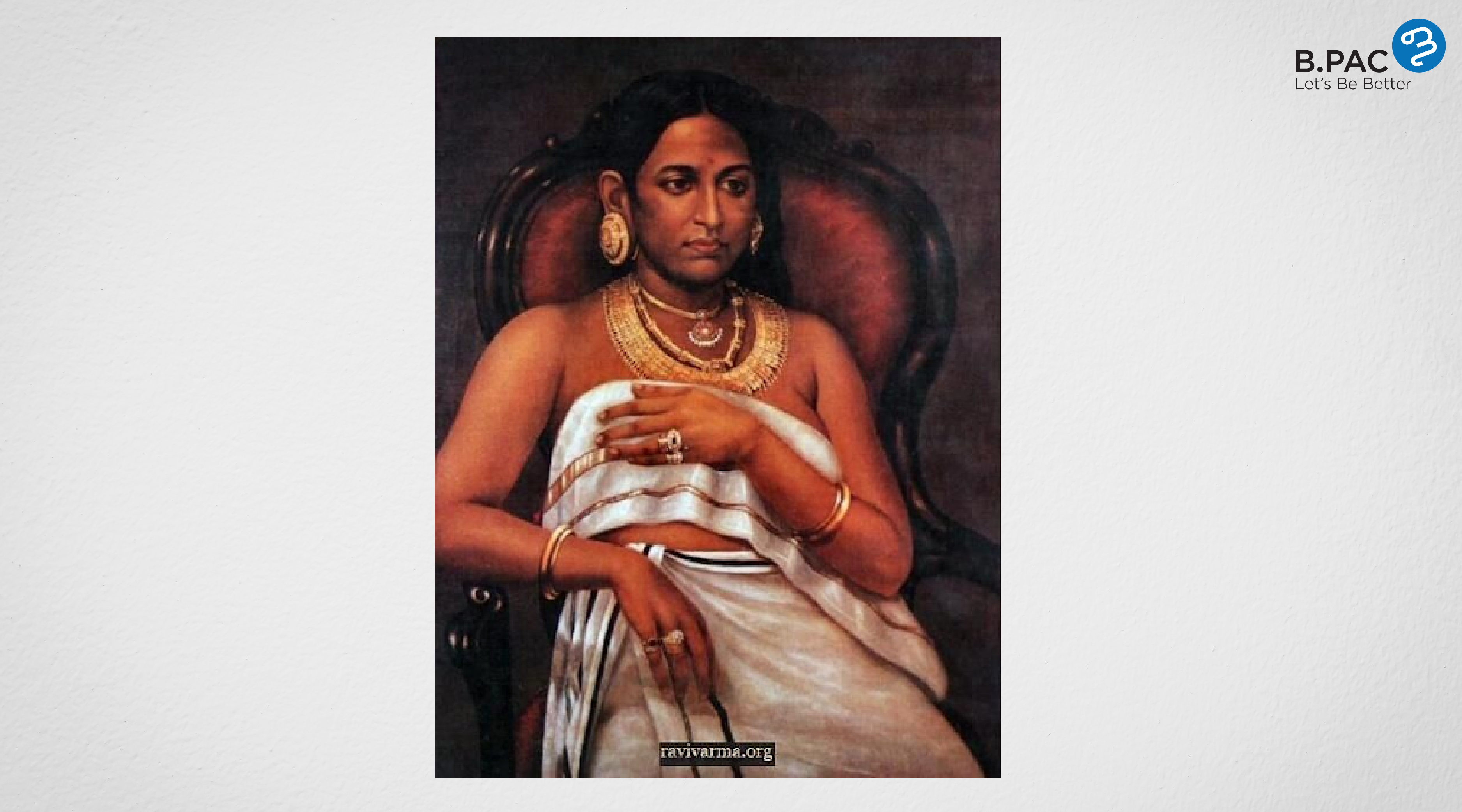
1885
Times of India ran an advertisement for Southhall’s Sanitary Towels, manufactured by Southhall Brothers from Birmingham in 1885. The pads were initially distributed in Calcutta, Bombay & Poona retailers & were marketed as medical products.
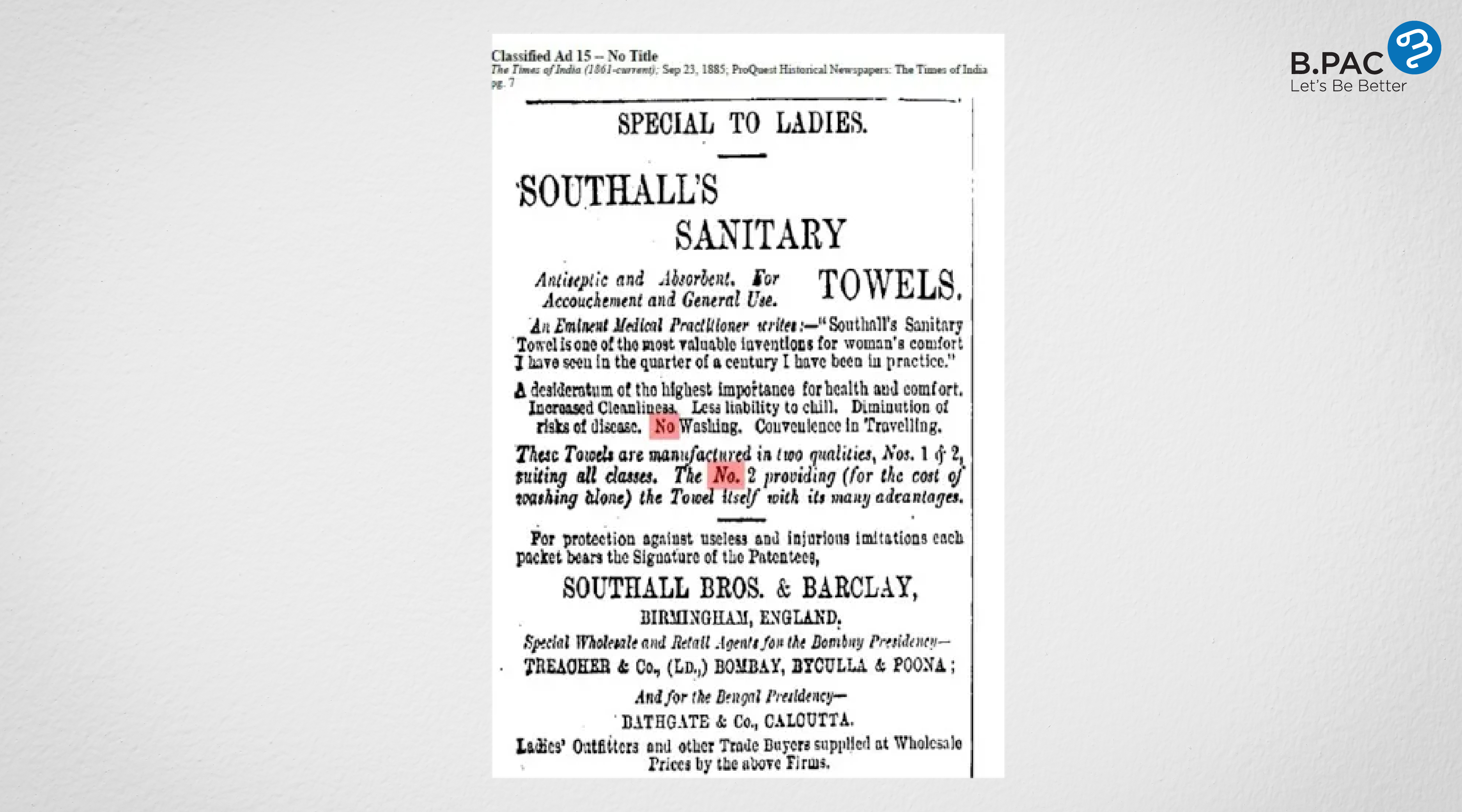
The 1980s – 1990s
Silence around menstruation grew intense due to growing taboo & superstitions. Menstruation was often transcoded as “Shadows which so regularly come to their lives”. Women used menstrual cloths made of rags with strings tied around the waist. In the desert regions of Rajasthan women wore garments with rectangular shaped pockets filled with sand to use as an absorbent. Women often visited traditional healers – the bhopa – for herbs & medicines to cure issues of PMS. One of the common superstitious practices was hiding menstrual cloth in dark corners away from men in the belief that they would go blind if they saw it.
1998
A young man named Arunachalam Muruganantham invented low cost sanitary pads after discovering that his wife collects filthy rags & newspapers for her periods. This life story was showcased in bollywood movie Pad Man.
The 2000s- Present
Despite significant developments in the country, stigma around menstruation is still deeply entrenched in society. Many Govt. organizations & NGOs are working together to create awareness & eradicate period poverty. Urban women can now easily access menstrual hygiene products yet many women in rural areas still use unhygienic alternatives like cloths & leaves.
Since ancient India, menstruation has been seen with diverse views. It is often considered a purification period and not dirty and impure bodily function and was deemed auspicious in many cultures. A menstruating woman was treated like a goddess as if society was amazed at how women could bleed out of their bodies and not die. In some regions of Assam and Orissa, the rituals of the menstruation of the goddesses are celebrated during the monsoon season. An annual festival called Ambubachi Mela is held every year in Assam when goddess Kamakhya is believed to be on her menstrual cycle. The 4-days festival attracts millions of pilgrims. It is a common belief that both the fertile earth and women on menstruation must be celebrated & allowed to rest.
Matter of Crimson Pride
Today, somehow, over time, the same culture that used to celebrate menstruation of a woman forbids them from engaging in essential daily activities and treats them as untouchables during menstruation. Apart from modern-day social inequity, women are still not allowed to visit worship places, touch holy objects or enter the kitchen during their menstruation period even today. Several people from remote areas associate menstruation with evil spirits and believe the body emits a certain kind of evil ray which spoils the food if touched by a menstruating woman. Consequently, women are banned from the kitchen during cycles and are encouraged to bury rags or sanitary napkins, thereby stifling the evil spirit. During ancient times, due to lack of medical advancements & biological knowledge, people often believed in baseless superstitions, but now with sufficient information & medical knowledge, menstruation is no longer a mystery. Then why do the stigma & misconceptions still govern the minds of people ? The consequence of ancestral ideology passed down through several generations still bites a woman in her uterus, for she can carry out & nurture human existence.
The dualism regarding women’s role in a society where they are either treated as holy, inviolable or polluted and impure has exposed humanity’s gender-biased & hypocritic nature. This clearly shows the cultural journey has gone from “riches to rags”. The physical evolution of humanity is not enough; we must also evolve our mindsets and work towards eradicating social myths & misconceptions for the betterment of society as a whole.


